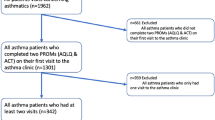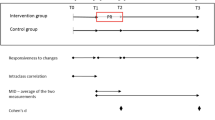Abstract
Background
Patient-perceived change in health-related quality of life (HRQoL) domains has often been classified using a 15-point patient transition rating scale. However, traditional change levels of trivial ( − 1, 0, or 1), minimal (2, 3 or − 2, − 3), moderate (4, 5 or − 4, − 5) and large (6, 7 or − 6, − 7) on this scale have been arbitrarily defined and originally assumed that change related to an improvement was the same as that for a decline.
Objective
To compare traditional and Rasch partial credit model-derived cut points and the mean changes for each change categorization when assessing clinically important change in asthma-specific HRQoL.
Methods
Our sample included 396 asthmatic outpatients who completed bimonthly telephone interviews on the Asthma Quality of Life Questionnaire and transition rating items over 1 year of participation. We employed item response theory in a novel approach to identify cut points on domain-specific HRQoL change data and transition ratings. After determining natural cut points for minimal, moderate, and large differences on the transition rating anchor, we calculated mean changes under change categorizations for both improvements and declines for the two transition rating classification approaches.
Results
Although traditional and Rasch categorizations for small, moderate, and large changes slightly differed and displayed a lack of symmetry between improvements and declines, nearly all mean changes between classification approaches were comparable.
Conclusions
In this study, traditional transition rating cut points remain suitable to assess HRQoL clinical significance in outpatients with asthma.
Similar content being viewed by others
References
Guyatt G, Norman G, Juniper E, Griffith L (2002) A critical look at transition ratings. J Clin Epidemiol 55:900–908
Institute of Medicine (2001) Crossing the Quality Chasm: A New Health System for the 21st Century. National Academy Press, Washington, DC
Kazdin A (1999) The meanings and measurement of clinical significance. J Consult Clin Psychol 67(3):332–339
Fairclough D (2002) Design and Analysis of Quality of Life Studies in Clinical Trials. Chapman & Hall/CRC, Raton, FL
Kendall P (1999) Clinical significance. J Consult Clin Psychol 67:283–284
Crosby R, Kolotin R, Williams G (2003) Defining clinically meaningful change in health-related quality of life. J Clin Epidemiol 56:395–407
Jaeschke R, Singer J, Guyatt G (1989) Measurement of health status: Ascertaining the minimal clinically important difference. Con Clin Trial 10:407–415
Jenkinson C, Peto V, Coulter A (1994) Measuring change over time: A comparison of results from a global single item of health status and the multi-dimensional SF-36 health status survey questionnaire in patients presenting with menorrhagia. Qual Life Res 3:317–321
Morris J, Perez D, McNoe B (1998) The use of quality of life data in clinical practice. Qual Life Res 7:85–91
Mozes B, Maor Y, Shmueli A (1999) Do we know what global ratings of health-related quality of life measure? Qual Life Res 8:269–273
Juniper E, Guyatt G, Willan A, Griffith L (1994) Determining a minimal important change in a disease-specific quality of life questionnaire. J Clin Epidemiol 47:81–87
Norman G, Stratford P, Regehr G (1997) Methodological problems in the retrospective computation of responsiveness to change: The lessons of Cronbach. J Clin Epidemiol 50(8):869–879
Samsa G, Edelman D, Rothman M, Williams G, Lipsccomb J, Matchar D (1999) Determining clinically important differences in health status measures: A general approach with illustration to the Health Utilities Index Mark II. Pharmacoeconomics 15(2):141–155
Cella D, Hahn E, Dineen K (2002) Meaningful change in cancer-specific quality of life scores: Differences between improvement and worsening. Qual Life Res 11:207–221
Wyrwich K, Tierney W, Wolinsky F (2002) Using the standard error of measurement to identify important intra-individual change on the Asthma Quality of Life Questionnaire. Qual Life Res 11(1):1–7
Wolinsky F, Wyrwich K, Metz S, Babu A, Tierney W, Kroenke K (2004) Test–retest reliability of the Mirowsky-Ross 2 × 2 Index of the Sense of Control. Psychol Rep 94(2):725–732
Wolinsky F, Wyrwich K, Kroenke K, Babu A, Tierney W (2003) 9-11, personal stress, mental health, and sense of control among older adults. J Gerontol Series B-Psychol Sci Soc Sci 58(3):S146–S150
Roth P, Switzer F, Switzer D (1999) Missing data in multiple item scales: A Monte Carlo analysis of missing data techniques. Organiz Res Meth 2(3):211–232
Joreskog K, Sorbom D (2002) LISREL 8.52 Software. Scientific Software International, Lincolnwood, IL
du Toit M, du Toit S (2001) Interactive LISREL: User’s Guide. Scientific Software International, Lincolnwood, IL
Juniper E, Guyatt G, Ferrie P, Griffith L (1993) Measuring quality of life in asthma. Am Rev Respir Dis 127:832–838
Wyrwich K, Metz S, Babu A, Kroenke K, Tierney W, Wolinsky F (2002) The reliability of retrospective change assessments. Qual Life Res 11(7):636
Guyatt G, Nogradi S, Halcrow S, Singer J, Sullivan M, Fallen E (1989) Development and testing of a new measure of health status for clinical trials in heart failure. J Gen Intern Med 4:101–107
Wyrwich K, Nelson H, Tierney W, Kroenke K, Babu A, Wolinsky F (2003) Clinically important differences in health-related quality of life for patients with asthma: An expert panel report. Ann Allergy Asthma Immunol 91(2):148–153
Embretson S, Reise S (2000) Item Response Theory for Psychologists. Lawrence Erlbaum Associates, Mahwah, NJ
Bond T, Fox C (2001) Applying the Rasch Model: Fundamental Measurement in the Human Sciences. Lawrence Erlbaum, Mahwah, NJ
Masters G, Wright B (1997) The partial credit model. In: van der Linden W, Hambleton R (eds) Handbook of Modern Item Response Theory. Springer, New York, pp. 101–121
Fischer G, Ponocny I (1994) An extension of the partial credit model with an application to the measurement of change. Psychometrika 59:177–192
Muraki E (1997) A generalized partial credit model. In: van der Linden W, Hambleton R (eds) Handbook of Modern Item Response Theory. Springer, New York, pp. 153–164
Samejima F (1997) Graded response model. In: van der Linden W, Hambleton R (eds) Handbook of Modern Item Response Theory. Springer, New York, pp. 85–100
Smith R, Suh K (2003) Rasch fit statistics as a test of the invariance of item parameter estimates. J Appl Meas 4(2):153–163
Schumacker R, Lomax R (2004) A Beginner’s Guide to Structural Equation Modeling, 2nd edn. Lawrence Erlbaum, Mahwah, NJ
Linacre J (2003) A User’s Guide to WINSTEPS MINISTEP: Rasch-model Computer Programs. John M. Linacre, Chicago, IL
Linacre J. WINSTEPS 3.37 Rasch Measurement for Windows. Chicago, IL: John M. Linacre, 2001
SPSS 12.0.1 for Windows. Chicago, IL: SPSS Inc., 2003
Norman G, Sridhar F, Guyatt G, Walter S (2001) The relation of distribution- and anchor-based approaches in interpretation of changes in health-related quality of life. Med Care 39(10):1039–1047
Norman G (2003) Hi! How are you? Response shift, implicit theories and differing epistemologies. Qual Life Res 12:239–249
Ross M (1989) Relation of implicit theories to the construction of personal histories. Psychol Rev 96(2):341–357
Schwartz N, Sudman S (1994) Autobiographical Memory and the Validity of Retrospective Reports. Springer-Verlag, New York
Acknowledgement
Supported by grants from the Agency for Healthcare Research and Quality to Dr Wolinsky (R01 HS10234) and Dr Wyrwich (K02 HS11635). We would also like to thank Mike Linacre for his thoughtful comments throughout the analytic process.
Author information
Authors and Affiliations
Corresponding author
Rights and permissions
About this article
Cite this article
Metz, S.M., Wyrwich, K.W., Babu, A.N. et al. A comparison of traditional and Rasch cut points for assessing clinically important change in health-related quality of life among patients with asthma. Qual Life Res 15, 1639–1649 (2006). https://doi.org/10.1007/s11136-006-0036-6
Accepted:
Published:
Issue Date:
DOI: https://doi.org/10.1007/s11136-006-0036-6




